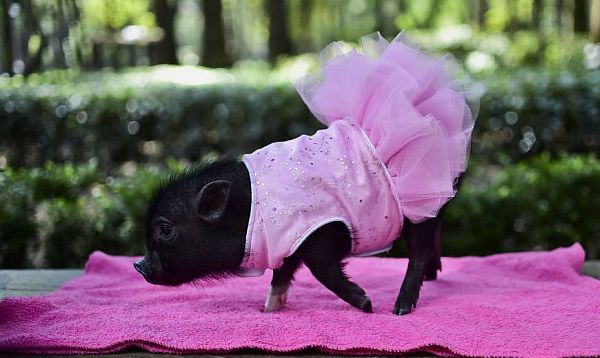Mexico City – The pet at the end of the leash is tiny, chubby and wears a little sweater as it is paraded down a Mexico City street by its owner.
But this is no poodle or chihuahua - it is a miniature pig, the new pet craze in the capital, where growing numbers are opting for porcine companions over canines.
"We're a bit crazy in our family," said Tania Loaeza, a housewife who has owned her pint-size pig for a month. "I saw Vietnamese little pigs at a farm, and I fell in love with one. I said, 'I want one, I want one!' And then Miku arrived."
Miku is part of the family now, running, squealing and playing with her son.
"She's like a little sister," Loaeza said. And contrary to what one may expect, "she's house-trained and warns my husband when she needs to go out."
Miniature pigs have been adopted as pets in other parts of the world, but they are a new sight in Latin America and Mexico, where they have become a status symbol, selling for as much as $1,800.
Seeing pigs as pets comes as a surprise in a country known for its love affair with pigs as comestibles - as pork rinds (chicharron) or tacos filled with spit-roasted meat.
Xhantal Bobadilla, a veterinarian, began a miniature-pig breeding business after getting one for herself and noticing their popularity.
"People have a pleasant reaction when they see a minipig," Bobadilla said as a tiny black creature in a pink tutu curled up in her lap during a cold morning at a park while dogs sniffed suspiciously at her second porcine pet.
With two females and a male, Bobadilla and her business partner, Daniel Munoz, have raised 12 pigs. Ten have been sold, and they have requests from around Latin America through their Facebook page, MiniPigs DF, the initials for the capital's federal district.
 |
Jose Alanis, a veterinarian and miniature-pig expert, estimates that there are 3,000 of the diminutive companions in Mexico, including 2,000 in the capital of 20 million people. "They have become fashionable through social media and socialites like Paris Hilton," he said. They sell for between $360 and $1,800. The pink ones are the most in demand, he added.
Miniature pigs are the result of selective breeding that began half a century ago, mixing small specimens from Vietnam and Europe to use them for lab experiments because some of their genes are similar to those of humans.
Miniature pigs weigh less than 40 kilograms (88 pounds).
"Working with big, heavy animals was not functional," said Alanis, who used to raise miniature pigs for biomedical research. "And now they've gone from the farm to the home. It's a trend that's on the rise. It will stabilize and then decline, but it won't disappear."
Bobadilla helps her clients learn how to care for miniature pigs and understand the ways they communicate and act. "When it gets cold, they go behind the fridge because of the heat that comes out of the back of the appliance," she said.
"The first thing they identify is the kitchen. They're always hungry. They ask for food with the classic 'oink oink,' but if you ignore them, they squeal," she said. "They're shy because in nature they're prey. But they're not too dependent. You can leave them alone and, unlike dogs, they won't suffer and wait for you behind the door."
For her partner Munoz, miniature pigs are smarter than dogs. "They're clean, they don't smell bad because they don't have sweat glands. And since they're hypo allergenic, people with allergies can live with them," he said.
Alanis said it usually takes 18 months for somebody to determine whether they are happy having a miniature pig.
And if they are not? The vet admits she once heard of a miniature pig coming to a sticky end after animal control officers found it abandoned in the capital.
"Nobody claimed it and, you know, it ended up in a pot," they told him.
Source: Japan Times


